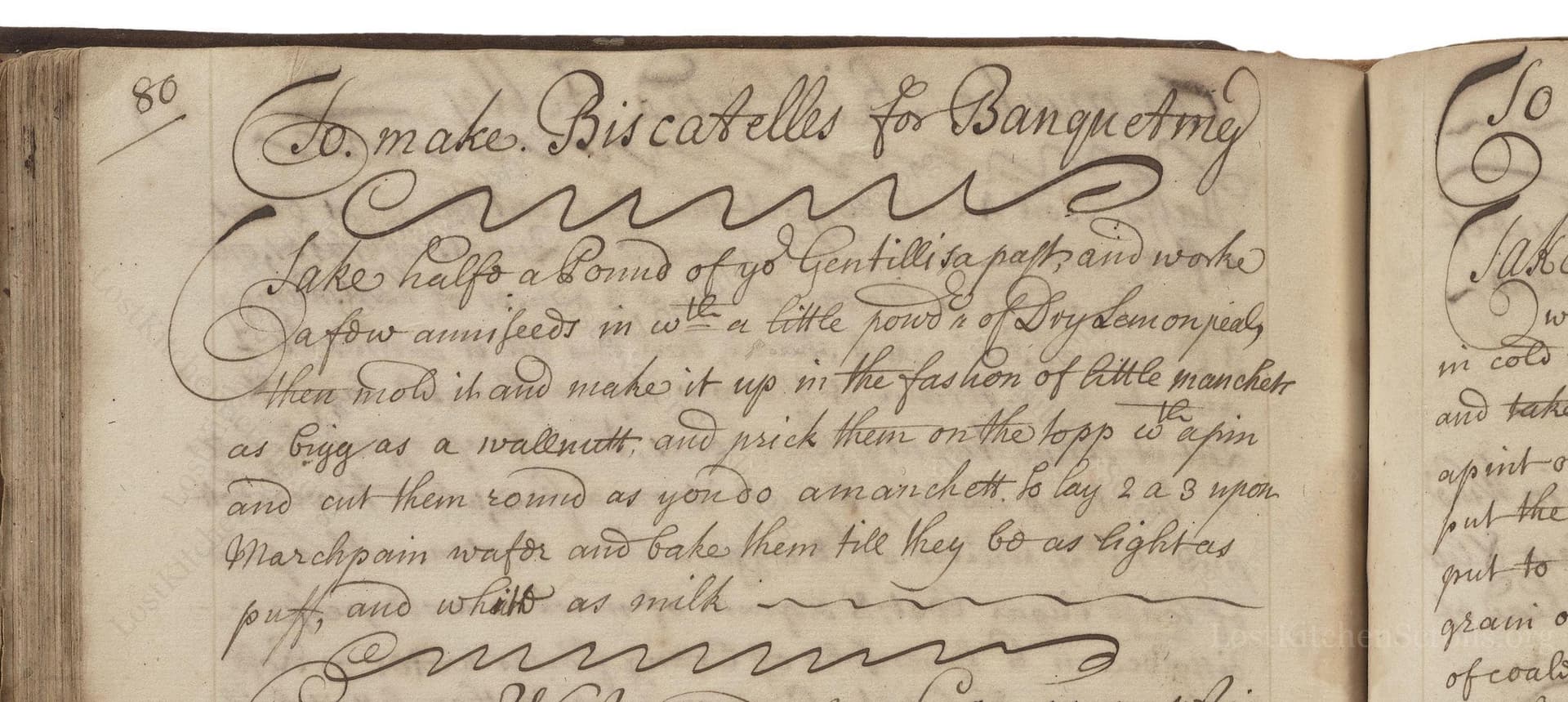To Make Biscatells For Banquetting
From the treasured pages of English cookery and medicine book,
Unknown Author

To Make Biscatells For Banquetting
"Take halfe a Pound of ye Gentillisa past and worke with a little powdr of dry lemon pealy, then mold it and make it up in the fashon of little manchets as bigg as a walnutt, and prick them on the topp with a pin and cut them round as you do a manchett, to lay 2 a 3 upon Marchpain wafer and bake them till they be as light as puff, and white as milk."
Note on the Original Text
The recipe is typical of its era—concise, trusting the cook’s experience for specifics, and rich with period spelling like 'manchett' (a type of bread roll) and 'powdr' (powder). 'Gentillisa past' refers to a refined almond-based paste, akin to modern marzipan. Descriptions like 'as light as puff and white as milk' point to a desired texture and color, critical visual cues before kitchen timers existed. Directions reference common shapes and tasks of the time (scoring like a 'manchett') as mnemonic aids, while the brevity of ingredient lists reflects both cost and the elite setting where such recipes were made.

Title
English cookery and medicine book, (1694)
You can also click the book image above to peruse the original tome
Writer
Unknown
Era
1694
Publisher
Unknown
Background
A delightful journey through late 17th to early 18th-century kitchens, this tome features recipes, culinary wisdom, and mouthwatering secrets from an era where feasts reigned supreme and the art of cooking was celebrated with flourish.
Kindly made available by
Folger Shakespeare Library
This delightful recipe hails from a late-17th to early-18th century English manuscript, likely made for the decadent banqueting tables of wealthy households between 1677 and 1711. Biscatells belong to a class of delicate, sweet confections intended for the final course of an elaborate feast, when elegant marzipan treats and sugar works were highly prized. Such recipes were often passed within elite circles, gracing special occasions and gatherings where culinary artistry was on display.

To craft Biscatells in the period, cooks would have used a mortar and pestle for grinding dried lemon peel, a sturdy work surface for kneading the almond paste, pins (common kitchen tools, both for marking and for fine decorative detail), knives for cutting the characteristic rounds, wafer sheets (Marchpain wafer) baked ahead from starch or extra-fine flour, and a wood-fired oven, keenly watched so that the biscuits remained pale and did not brown.
Prep Time
15 mins
Cook Time
15 mins
Servings
10
We've done our best to adapt this historical recipe for modern kitchens, but some details may still need refinement. We warmly welcome feedback from fellow cooks and culinary historians — your insights support the entire community!
Ingredients
- 8 ounces marzipan or almond paste (Gentillisa paste wasn't standardized, but marzipan is the closest replacement)
- 1/2 to 1 teaspoon dried lemon peel (zest), finely ground
- Parchment paper (as substitute for Marchpain wafer)
Instructions
- To recreate historical 'Biscatells' for a banquet, begin with 8 ounces (half a pound) of marzipan (almond paste).
- Work in about 1/2 to 1 teaspoon of dried lemon zest.
- Knead this mixture well, then shape it into small balls about the size of a walnut (roughly 1 1/4 to 1 1/2 inches in diameter).
- Lightly prick the top of each ball with a toothpick or skewer, and use a knife to gently score a circle around the top as you would a classic bread roll.
- Place 2 or 3 of these on a parchment-lined baking tray (parchment paper serving here as a substitute for 'Marchpane wafer').
- Bake at 300°F (150°C) until the biscuits are puffed and remain pale—about 12-18 minutes.
- The finished Biscatells should be very light and milky white in appearance, not golden brown.
Estimated Calories
90 per serving
Cooking Estimates
Preparing Biscatells takes about 15 minutes to knead and shape the marzipan, plus another 15 minutes in the oven. Each Biscatell has around 90 calories. This recipe makes 10 pieces.
As noted above, we have made our best effort to translate and adapt this historical recipe for modern kitchens, taking into account ingredients nowadays, cooking techniques, measurements, and so on. However, historical recipes often contain assumptions that require interpretation.
We'd love for anyone to help improve these adaptations. Community contributions are highly welcome. If you have suggestions, corrections, or cooking tips based on your experience with this recipe, please share them below.
Join the Discussion
Rate This Recipe

Den Bockfisch In Einer Fleisch Suppen Zu Kochen
This recipe hails from a German manuscript cookbook compiled in 1696, a time whe...

Die Grieß Nudlen Zumachen
This recipe comes from a rather mysterious manuscript cookbook, penned anonymous...

Ein Boudain
This recipe comes from an anonymous German-language manuscript cookbook from 169...

Ein Gesaltzen Citroni
This recipe, dating from 1696, comes from an extensive anonymous German cookbook...
Browse our complete collection of time-honored recipes



